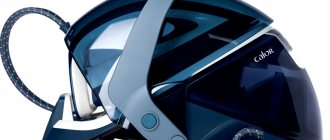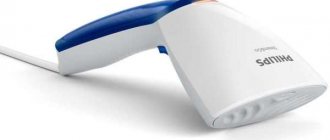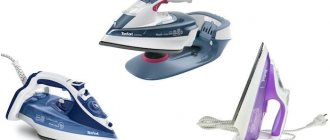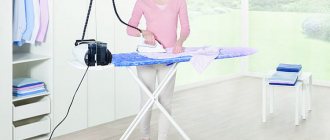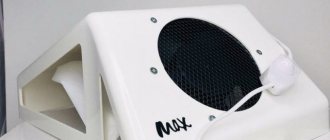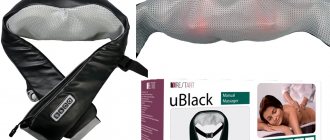What is the difference between an iron and a steamer?
The steamer and the iron differ not only in appearance. Their design and operating principle are also different.
So, the iron has its own characteristic features:
- The heating element is hidden in a metal platform.
- A terminal block is used to secure the power cord.
- There is a water container inside the case.
- Temperature regulation is carried out by a thermostat.
- Steam is produced by a special button, the supply intensity is set by the regulator.
After switching on, the sole is heated to the required temperature. After pressing the steam boost button, water from the container enters the tank in small portions. A hidden heating element instantly heats the water, it turns into steam and comes out through the holes in the sole. After being plugged in, the iron, on average, warms up within 2-10 minutes.
How does an iron with a steam generator differ from a steamer?
A steamer is an electrical appliance that consists of a small boiler, a telescopic tube and a nozzle with a flexible hose. Its operating principle is as follows: liquid boils in a plastic boiler. The steam then rises naturally through the hose. Use the device 35-40 seconds after switching on.
Its functions:
- ironing things in a hanging position;
- getting rid of the unpleasant aroma of the material;
- disinfection of children's soft toys;
- washing and ironing curtains located on the ledge;
- window cleaning;
- cleaning upholstered sofas and armchairs.
It should be understood that a steamer cannot replace a standard iron. Things can be ironed perfectly, especially those made from “capricious” materials, but the device will not give the required shape. He will not cope with pants with arrows and pleated skirts.
A steamer is needed for shops, ateliers, and wedding dress salons. You can buy it if you have a large amount of knitted, silk and woolen clothes, items trimmed with beads and sequins in your wardrobe.
The device perfectly refreshes down jackets, coats and other outerwear. It helps tidy up your apartment and get rid of germs and mites.
A steam generator is a device that consists of a tank of liquid, a flexible hose and the iron itself. Often, instead of the last part, a brush or a special conical nozzle is put on to remove dirt.
Then the principle of operation will be slightly different: water is brought to a boil, steam is formed, and it is intensively released into the hose. This does not happen naturally, as in the previous device, but under pressure. Steam is dry, not wet. The temperature will be much higher.
An iron with a steam generator can process several layers of material at the same time. Housewives emphasize the high speed of ironing towels and bedding. The device creates folds on things when necessary and easily copes with large amounts of clothing.
But it is not suitable for cleaning. Using the device, you can iron the curtains while hanging, but you won’t be able to clean them.
A steam generator is purchased in the following cases:
- Regular ironing of a mountain of clothes is necessary.
- Sitting at the ironing board for a long time can be very tiring.
- There are many items of delicate materials that are difficult to handle with a standard iron.
A conventional device is inferior to a steam generator in the speed of the ironing process. The liquid capacity of the latter can hold up to 3 liters (usually 1 liter), so there is no need to constantly add water.
A steam generator cannot completely replace a steamer. It is inferior in cleaning functions because the device is large in size and difficult to carry. In order to process curtains in a suspended state, you will need to rearrange the device several times, placing it on a small table, because the hose does not always reach the required place.
The main differences between the devices:
- The steam from the steamer is wet, its temperature is 98-99 degrees, while the steam from the steam generator is dry, the temperature is higher (140-160 degrees).
- In a steam generator, steam is supplied under pressure, while in a steamer it occurs naturally, similar to a kettle.
- To start working with the steam generator, you need to wait 8-10 minutes. The steamer is ready for ironing after 30-45 seconds.
- The steam generator is heavier and costs more.
- An iron with a steam generator operates in a vertical and horizontal position, a steamer is used exclusively for vertical ironing (otherwise the liquid will spill out).
- A steamer can be used to disinfect and clean a room, while a steam generator is only suitable for ironing.
Can a steamer replace an iron?
The preferred use of a particular device depends on what needs to be done daily - ironing or steaming.
Therefore, when choosing a device, you need to consider the following factors:
- When all family members need to wear ironed clothes every day, then a steamer or steam generator would be most suitable for such cases. The steamer can handle large volumes of clothing faster. At home it successfully replaces the iron.
- If we are talking about ironing 2-3 items, then you can get by with a regular iron with a steam function. With small volumes, the quality of ironing will always be at a high level.
- If you have the finances, you can buy two devices and use them, depending on the amount of clothes that need to be ironed.
Tips on what to choose
When choosing whether to buy a steam iron or a steamer for your home, pay attention to your belongings. If among them there are no classic trousers with arrows and similar products, you can safely buy a steam generator. If you need to give something a certain shape, you cannot do without an iron and ironing board.
In conclusion, we can say that a steam generator is optimal when used in stores, when there are a large number of decorative inserts and decorations on clothes, and if necessary, often and a lot of ironing. An iron is a classic option, needed for ironing items for newborns, giving shape to textiles, and copes better with natural fabrics. There are good reviews about both devices, it all depends on your personal preferences.
How to make a choice
The ironing device is selected according to certain parameters.
Speed and quality of ironing
The speed of operation is affected by the intensity of steaming. The more active the steam is, the better it affects the folds and straightens them. The steamer and steam generator allow you to iron clothes hanging on a hanger. The device does not touch the fabric at all and straightens the folds from a distance due to the action of steam. Severe defects are smoothed out in several passes over the same area.
Sole
The soles of ironing devices are made of different materials:
- Aluminum. Lightweight and cheap metal. Such soles are difficult to clean, they gradually become deformed and leave a gloss. Therefore, surfaces are covered with ceramics and other materials for protection.
- Steel. Such soles are characterized by long and uneven heating. The high density of the material ensures a long service life. The application of a ceramic or Teflon coating helps improve glide.
- Ceramics. It is found mainly in the form of coatings. Ceramic soles are rarely found in their pure form.
Water tank
When choosing a device, you need to pay attention to:
- Can the container be removed before filling with water?
- Dimensions and shape of the water hole.
- Presence of a scale filter.
Additional options
- Self-cleaning system.
- Steam supply: automatic or manual option.
- Presence of steam boost.
- Possibility of vertical steaming.
- Automatic shutdown of an unused device.
- Rollover lock.
- Click when ready to use.
What parameters to pay attention to when purchasing
Performance is directly related to the power of the equipment and determines how thick fabrics such a steamer can iron and how quickly it can handle them.
The average flow rate is 30-50 ml/min - this is enough to tidy up home textiles and most of the things in your wardrobe. Vertical steamers of the mid-price category with a power from 1500 to 2300 W have these parameters. They can handle one thing in 1.5-2 minutes.
Most budget and manual models have a much lower supply intensity (13-20 ml/min) with a power of up to 1.5 kW. It will take them about 3 minutes to steam, say, a man's shirt.
The larger the volume of the water tank , the longer the continuous operation of the device will be. And, therefore, you can process more things and do it more carefully. Continuous operation time also depends on the volume of the tank. All modern steamers with a tank volume of more than 1 liter will work for a long time.
That is, the clothes steamer, after connecting and drawing water, should begin to work after a certain wait, during which the water will turn into steam. The indicator of readiness for work is not decisive, since almost all models have approximately the same characteristics: 45-60 seconds.
Functional
In terms of their functions, irons and steamers are very similar and differ only slightly from each other.
Vertical steaming
This feature is available on all products starting from the below average price. This procedure can be performed with an iron, but it is inconvenient. It is difficult to hold a heavy device suspended, and the steam boost must be turned on periodically. After the steam comes out, the iron should return to temperature. In steamers, steam is supplied continuously in large quantities. The lightweight iron can be held freely in weight.
Steamer
How the steamer works
The design of the steamer consists of the following parts:
- Steam generator.
- Container with heating element.
- Special nozzles.
Steaming occurs without contact. The steam simultaneously smoothes and disinfects fabrics.
Advantages and disadvantages
More gentle effect on the fabric compared to the soleplate of the iron. Does not damage decor - beads, rhinestones, etc.
The large volume of water in the boiler ensures long-term operation.
In addition to wrinkles, old dried stains and unpleasant odors are eliminated.
Vertical processing does not require an ironing board.
The device must not be turned over to avoid burns.
Natural fabrics require increased power.
High cost of modern devices.
Their advantages and disadvantages
Advantages of the steam generator:
- Dry steam, which can be used for disinfection, eliminating dust mites.
- The action of high temperatures allows you to iron several layers of material at once. The device is a good option for processing large items, for example, bedding.
- It is allowed to tidy up delicate fabrics as long as you do not touch them with the soleplate of the device.
- It acts quickly, so the process time is significantly reduced.
- The water container is large, no need to add liquid when ironing.
- There is a control panel, thanks to which the required operating mode is selected. If necessary, you can even turn off the steam supply.
Disadvantages of the device:
- cannot be used in a vertical position;
- It will not help to clean the room.
Advantages of the steamer:
- Wet steam processes materials without deforming or squeezing fibers.
- After ironing, the clothes have additional volume.
- Can be used for all types of products, such as knitwear, fur, pile, items with decorative parts (ruffles, flounces), jackets, down jackets, coats.
- The device is perfect for cleaning rooms. It helps to clean dirt from carpets, wash curtains and curtains, without removing them from the cornice. Children's soft toys, upholstery of sofas and armchairs are disinfected. The device is even used for washing windows.
- Often the device is taken with you on a trip, which is why it is called a hand or travel iron.
- Working with the steamer begins almost immediately after pressing the power button.
Flaws:
- Quite low work intensity. The device will not iron very wrinkled clothes, so it should not be considered as a purchase in place of an iron.
- Disinfection will be less effective since the steam temperature is not very high.
Iron
Irons are most often used in everyday life for their intended purpose. The main components are:
- Platform with heating element.
- Water container.
- Thermostat.
- Electrical cord.
All modern models with a steamer. Steam is applied evenly to delicate fabrics, and dense materials are treated with a steam boost.
Advantages and disadvantages
Ideally irons bed linen, cotton and linen items.
Doesn't require much storage space.
Easy to carry, you can take it with you on the road.
Relatively low price.
After filling with water, it gains additional weight and mobility is lost.
Capacity no more than 400 ml.
The steam pressure is low and requires effort when ironing.
The cord is not always long enough.
Need an ironing board.
What is best to use and when?
What is the difference? At home, both a steam generator and an iron perform similar functions.
But in some situations, using one of the devices is preferable, for example:
Iron
- will help to make high-quality “arrows” on trousers, form folds on a skirt;
- folding irons are convenient to take with you on trips;
- oddly enough, modern models often show better results in ironing quality tests;
- The device is familiar and therefore more convenient to use.
Steam generator
- can clean carpet, upholstered furniture, fabric coverings;
- allows you to straighten hanging curtains and drapes;
- helps to carry out high-quality cleaning of the room without the use of chemicals;
- washes windows and glass surfaces (not all models);
- refreshes clothes well;
- steams almost any fabric, including thick and multi-layered ones.
